TIGER in Antarctica
November 29, 2001
First TIGER Pick Up
Today, we put TIGER up on the crane for the first time. It isn't quite ready to fly yet, but we wanted to get an early check on the radio and satellite communications systems, and a full check of the solar arrays.
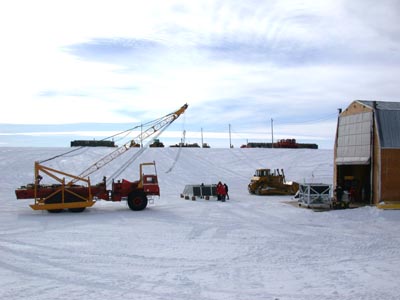 Photo on right: TIGER about to be picked up by crane
Photo on right: TIGER about to be picked up by crane
There are several different satellite communication systems onboard TIGER. We can get a lot of our data through the NASA Tracking and Data Relay Satellite System (TDRSS) and, if that fails, a little bit through the ARGOS satellite. There is also a Line-Of-Sight (LOS) transmitter that sends to a radio dish here at Willy Field. It only has a range of a few hundred miles, but it can send all of our data and will be extremely useful during the first couple days of flight. We also have the ability to send commands up to TIGER through the LOS, and through TDRSS. There is also a GPS tracker onboard. We want to test it all.
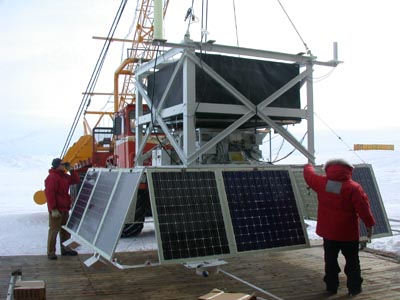 We open the big door of the barn and roll out the TIGER instrument (it's on a cart). We also hand carry out the solar arrays, which are lightweight, but delicate. I should make it clear that it is the National Scientific Balloon Facility (NSBF) crew that has constructed and is responsible for the communications package and the solar arrays. This test, called a "Hang Test" makes sure that our piece (TIGER) works with the NSBF pieces.
We open the big door of the barn and roll out the TIGER instrument (it's on a cart). We also hand carry out the solar arrays, which are lightweight, but delicate. I should make it clear that it is the National Scientific Balloon Facility (NSBF) crew that has constructed and is responsible for the communications package and the solar arrays. This test, called a "Hang Test" makes sure that our piece (TIGER) works with the NSBF pieces.
Photo on left: TIGER with solar arrays
TIGER gets hoisted up on the crane, and the solar arrays are attached beneath it by steel cables. This is the way TIGER will be launched. The crane will hold TIGER off the ground, and the balloon will rise up over the back of the crane. When the balloon has risen high enough to lift TIGER without having it hit the ground, and with the crane positioned directly below the balloon, TIGER and the balloon will be released.
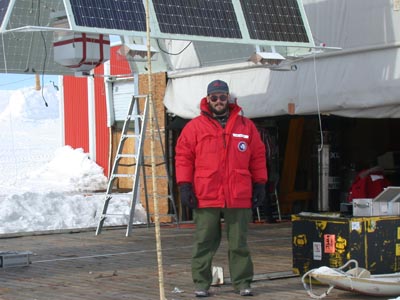 In the picture at right, you can see a box with red straps hanging under the instrument. This is the ballast hopper and contains 500 lbs of small steel shot. There is a valve at the bottom that is controlled from the ground so that ballast can be released. We won't need much ballast, because it is primarily used at sunset, which we won't have. It is still good to have some for altitude control anyway.
In the picture at right, you can see a box with red straps hanging under the instrument. This is the ballast hopper and contains 500 lbs of small steel shot. There is a valve at the bottom that is controlled from the ground so that ballast can be released. We won't need much ballast, because it is primarily used at sunset, which we won't have. It is still good to have some for altitude control anyway.
Photo on right: Eric standing under TIGER
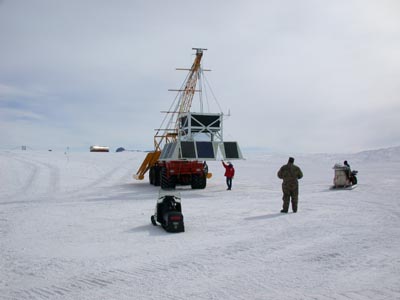 After everything is ready, the crane takes us away from the building and we run a few hours of tests. Everything works quite well. The solar arrays are generating more power than we need. We successfully send commands to TIGER and receive data from it through the LOS. The satellite links actually go to a computer in Palestine Texas (where NSBF is based), but with an internet connection to our machine in Palestine, we can send commands from either here or Washington University in St. Louis. The data, whether it comes LOS to us here, or through the satellites to Palestine, gets copied to McMurdo, Wash. U., Caltech, and Goddard.
After everything is ready, the crane takes us away from the building and we run a few hours of tests. Everything works quite well. The solar arrays are generating more power than we need. We successfully send commands to TIGER and receive data from it through the LOS. The satellite links actually go to a computer in Palestine Texas (where NSBF is based), but with an internet connection to our machine in Palestine, we can send commands from either here or Washington University in St. Louis. The data, whether it comes LOS to us here, or through the satellites to Palestine, gets copied to McMurdo, Wash. U., Caltech, and Goddard.
Photo on left: TIGER hang test
It all seems to work, but because of the limited satellite time we had scheduled, we weren't able to finish testing commanding from Wash. U. We'll want to try this one more time, but generally the day is a big success.
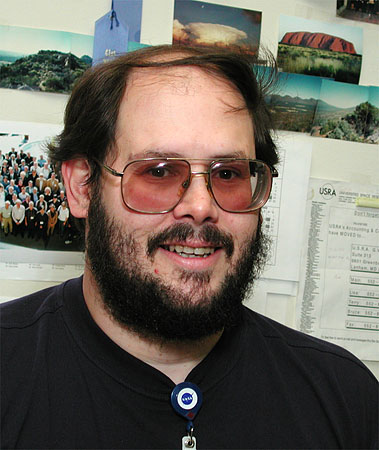
Dr. Eric R. Christian
Eric's Featured Scientist Profile
This page was last modified on December 19,
2002
|